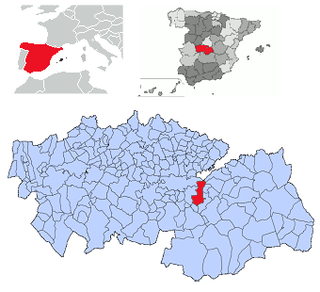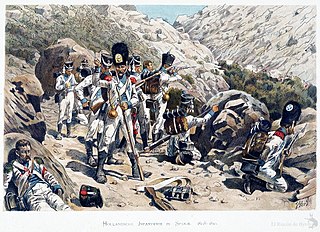
The Battle of Uclés saw an Imperial French corps led by Marshal Claude Perrin Victor attack a Spanish force under Francisco Javier Venegas. The French easily crushed their outnumbered foes, capturing over half of the Spanish infantry. Uclés is located in the province of Cuenca 15 kilometres (9.3 mi) east of Tarancón and 100 kilometres (62 mi) southeast of Madrid. The action occurred during what is called the Peninsular War in English-speaking countries and the Spanish War of Independence in Spain. The war was part of a larger struggle known as the Napoleonic Wars.

The Battle of Almonacid was fought on 11 August 1809 during the Peninsular War between Sébastiani's IV Corps of the French Peninsular Army, which King Joseph of Spain had withdrawn from the Battle of Talavera to defend Madrid, and the Spanish Army of La Mancha under General Venegas. After the decisive charges of Polish uhlans, the battle resulted in a French victory.
The Battle of Ciudad Real was fought on 27 March 1809 and resulted in a French victory under General Sebastiani against the Spanish under General Conde de Cartojal.

The Battle of Ocaña was fought on 19 November 1809 between French forces under Marshal Soult and King Joseph Bonaparte against the Spanish army under General Aréizaga, which suffered its greatest single defeat in the Peninsular War.

The Battle of Tudela saw an Imperial French army led by Marshal Jean Lannes attack a Spanish army under General Castaños. The battle resulted in the complete victory of the Imperial forces over their adversaries. The combat occurred near Tudela in Navarre, Spain during the Peninsular War, part of a wider conflict known as the Napoleonic Wars.

The Battle of Talavera was fought just outside the town of Talavera de la Reina, Spain some 120 kilometres (75 mi) southwest of Madrid, during the Peninsular War. At Talavera, a British army under Sir Arthur Wellesley combined with a Spanish army under General Cuesta fought in operations against French-occupied Madrid. The French army withdrew at night after several of its attacks had been repulsed.

The Battle of Somosierra took place on 30 November 1808, during the Peninsular War, when a combined Franco-Spanish-Polish force under the direct command of Napoleon Bonaparte forced a passage through a Spanish Division stationed at the Sierra de Guadarrama, which shielded Madrid from direct French attack. At the Somosierra mountain pass, 60 miles (97 km) north of Madrid, a heavily outnumbered Spanish detachment of regulars, volunteers and artillery under Benito de San Juan aimed to block Napoleon's advance on the Spanish capital. Napoleon overwhelmed the Spanish positions in a combined arms attack, sending the Polish Chevau-légers of the Imperial Guard at the Spanish guns while French infantry advanced up the slopes. The victory removed the last obstacle barring the road to Madrid, which fell several days later.

The Battle of Medina de Rioseco, also known as the Battle of Moclín, was fought during the Peninsular War on 14 July 1808 when a combined body of Spanish militia and regulars moved to rupture the French line of communications to Madrid. General Joaquín Blake's Army of Galicia, under joint command with General Gregorio de la Cuesta, was routed by Marshal Bessières after a badly coordinated but stubborn fight against the French corps north of Valladolid.
The Battle of Alcañiz resulted in the defeat of Major-General Louis Gabriel Suchet's French army on 23 May 1809 by a Spanish force under General Joaquín Blake y Joyes.
In the Peninsular War, the Battle of Medellín was fought on 28 March 1809 and resulted in a victory of the French under Marshal Victor against the Spanish under General Don Gregorio Garcia de la Cuesta. The battle marked the first major effort by the French to occupy Southern Spain, a feat mostly completed with the victory at the Battle of Ocana later in the year.
The Battle of Belchite on 18 June 1809 saw a Franco-Polish corps led by Louis Gabriel Suchet fight a small Spanish army under Joaquín Blake y Joyes. Suchet's force won the battle when a lucky hit detonated a large part of the Spanish ammunition supply. The ensuing blast provoked Blake's soldiers into a panicky flight from the battlefield. The action was fought during the Peninsular War, part of the Napoleonic Wars. Belchite is located 40 kilometres (25 mi) southeast of Zaragoza.
The Battle of Villafranca del Bierzo took place on 17 March 1809, during the French occupation of León in the Peninsular War. After a bloody four-hour siege the small and isolated French garrison at Villafranca surrendered to Spanish regulars under Brigadier José de Mendizábal and General Pedro Caro, 3rd Marquis of la Romana.

In the First Battle of Porto the French under Marshal Soult defeated the Portuguese, under General Parreiras, outside the city of Porto during the Peninsular War. Soult followed up his success by storming the city.

Jean Gabriel Marchand, 1st Count Marchand went from being an attorney to a company commander in the army of the First French Republic in 1791. He fought almost exclusively in Italy throughout the French Revolutionary Wars and served on the staffs of a number of generals. He participated in Napoleon Bonaparte's celebrated 1796-1797 Italian campaign. In 1799, he was with army commander Barthélemy Catherine Joubert when that general was killed at Novi. Promoted to general officer soon after, he transferred to the Rhine theater in 1800.

In the Battle of Alba de Tormes on 28 November 1809, an Imperial French corps commanded by François Étienne de Kellermann attacked a Spanish army led by Diego de Cañas y Portocarrero, Duke del Parque. Finding the Spanish army in the midst of crossing the Tormes River, Kellermann did not wait for his infantry under Jean Gabriel Marchand to arrive, but led the French cavalry in a series of charges that routed the Spanish units on the near bank with heavy losses. Del Parque's army was forced to take refuge in the mountains that winter. Alba de Tormes is 21 kilometres (13 mi) southeast of Salamanca, Spain. The action occurred during the Peninsular War, part of the Napoleonic Wars.

In the siege of Lérida from 29 April to 13 May 1810, an Imperial French army under Louis Gabriel Suchet besieged a Spanish garrison led by Major General García Conde. On 13 May, García Conde surrendered with his 7,000 surviving soldiers. Lleida (Lérida) is a city in the western part of Catalonia. Margalef is located about 10 kilometres (6 mi) southeast of Lérida. The siege occurred during the Peninsular War, part of the Napoleonic Wars.
The Battle of Carpio or Battle of El Carpio took place at El Carpio, near Medina del Campo, Valladolid, on 23 November 1809, between a Spanish force of 19,000 men commanded by the Lieutenant-General Diego de Cañas y Portocarrero, Duke del Parque and a French force of 10,000 regulars and 1,700 cavalry under the General François Étienne de Kellermann during the Peninsular War. The French forces were defeated and forced to leave the town. In this struggle, died two distinguished Spanish leaders, Salvador de Molina and Colonel Juan Drimgold.

The Dutch Brigade was a unit of the Royal Army of the Kingdom of Holland. King Louis Bonaparte sent the brigade in September 1808, to take part in the Peninsular War on the French side at the request of his brother Emperor Napoleon of France. The brigade was under the command of Major-General David Hendrik Chassé and was made part of the so-called "German Division". The Division also consisted of units from the Nassau, the Baden and other German allies of the French empire commanded by the French general Leval. It was, in turn, part of the IVth French Corps commanded by Marshals Lefebvre and Sébastiani, and was later part of the Marshal Victor's Ist Corps. The brigade distinguished itself initially in several major battles, and was later employed mainly in counter-guerrilla warfare. After the annexation of the Kingdom of Holland by the French empire in 1810, the brigade was formally decommissioned and its members, now French subjects, absorbed into the French 123rd Line Infantry Regiment, and later into the 130th Line Infantry Regiment. The other battalions of the 123rd remained in the Netherlands and were later reassigned to the Russian campaign of 1812.

The Battle of Arzobispo on 8 August 1809 saw two Imperial French corps commanded by Marshal Jean-de-Dieu Soult launch an assault crossing of the Tagus River against a Spanish force under José María de la Cueva, 14th Duke of Alburquerque. Alburquerque's troops rapidly retreated after suffering disproportionate losses, including 30 artillery pieces. El Puente del Arzobispo is located 36 kilometres (22 mi) southwest of Talavera de la Reina, Spain. The action occurred during the Peninsular War, part of a larger conflict known as the Napoleonic Wars.

The Spanish Army of the Peninsular War refers to the Spanish military units that fought against France's Grande Armée during a period which coincided with what is also termed the Spanish War of Independence.














